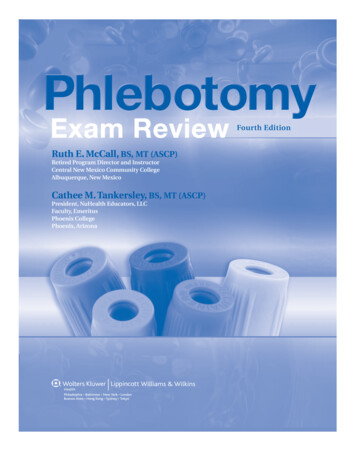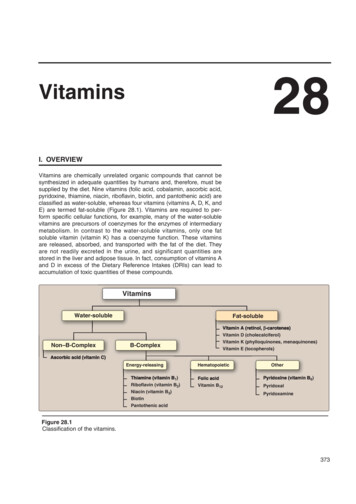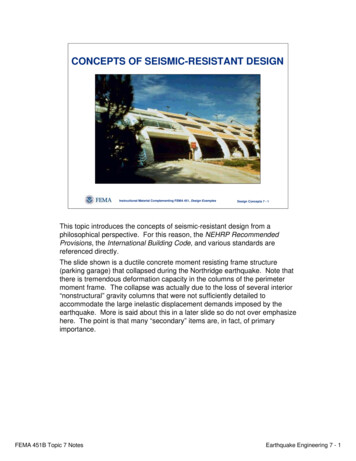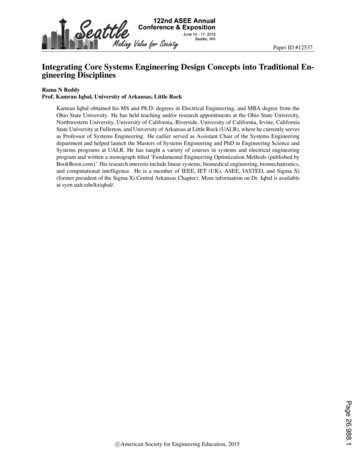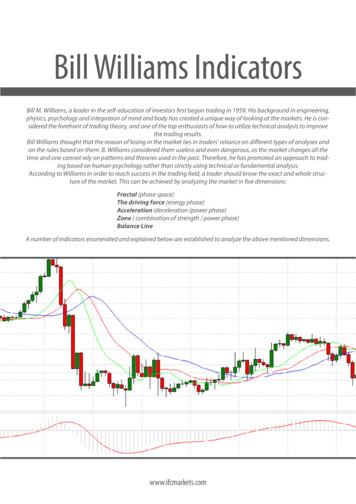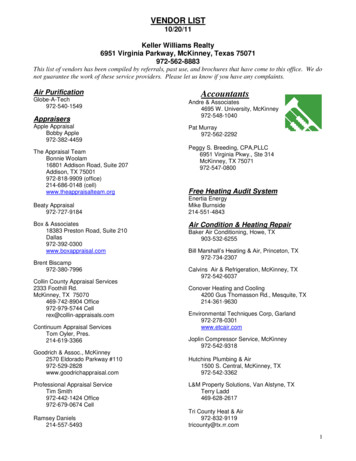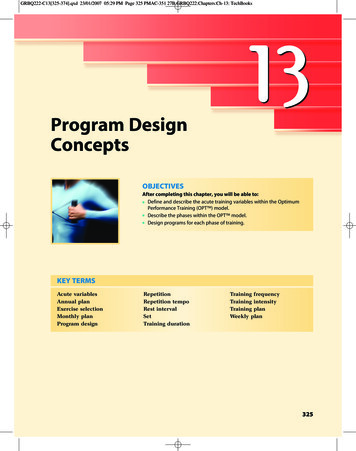
Transcription
GRBQ222-C13[325-374].qxd 23/01/2007 05:29 PM Page 325 PMAC-351 27B:GRBQ222:Chapters:Ch-13: TechBooksProgram DesignConcepts13OBJECTIVESAfter completing this chapter, you will be able to:Define and describe the acute training variables within the OptimumPerformance Training (OPT ) model.Describe the phases within the OPT model.Design programs for each phase of training.KEY TERMSAcute variablesAnnual planExercise selectionMonthly planProgram designRepetitionRepetition tempoRest intervalSetTraining durationTraining frequencyTraining intensityTraining planWeekly plan325
GRBQ222-C13[325-374].qxd 23/01/2007 05:29 PM Page 326 PMAC-351 27B:GRBQ222:Chapters:Ch-13: TechBooks326CHAPTER 13Program DesignINTRODUCTION TO PROGRAM DESIGNTraditionally, most training programs are based on the experiences of the healthand fitness professional (whether he or she is a bodybuilder, group exerciseinstructor, power lifter, Olympic lifter, or an athlete). This has led to many scientifically unsupported training programs that have created confusion for health andfitness professionals. Indeed, science has been slow to validate anecdotal evidencethat still continues to be used in the fitness world.1,2To be safe, effective, and productive, all health and fitness professionals mustbe competent at designing resistance-training programs for a variety of clients. Thisentails the proper utilization of acute variables (repetitions, sets, and so forth) andexercises in a structured, progressive manner. For many health and fitness professionals, this can become a daunting task, causing them to ask, “How many exercises should I use? How many sets and repetitions should I use? How many daysper week should my client train?” When using a structured, scientifically basedprogram design model, answers to these questions become very simple.WHAT IS PROGRAM DESIGN?Program design: A purposeful system or plan puttogether to help an individual achieve a specific goal.Program design simply means creating a purposeful system or plan to achieve aspecific goal. The key words here are “purposeful system.” The purpose of a training program is to provide a path for the client to achieve his or her goal. Providinga path requires the health and fitness professional to have a comprehensive understanding of a few key concepts:Acute Variables What are they? How do they affect the desired adaptation? How do they affect the overall training program?The OPT Model (Planned Fitness Training—Periodization) How and why must the physiologic, physical, and performance adaptations of stabilization, strength, and power take place in a planned, progressive manner to establish the proper foundation for each subsequentadaptation?The Five Phases of Training in the OPT Model How do these phases promote specific adaptations? What are the acute variables for each of the phases?Application Selecting the right exercises. Selecting the right acute variables. Applying both in a systematic manner to different populations with differentgoals.IS THERE AN EASIER WAY?Taking the Guesswork OutIf a health and fitness professional has a proven system that he or she can follow,the needed information can simply be plugged in, without the worry of using thecorrect formula for success. This is exactly what the OPT model provides (Figure13-1).
GRBQ222-C13[325-374].qxd 23/01/2007 05:29 PM Page 327 PMAC-351 27B:GRBQ222:Chapters:Ch-13: TechBooksPROGRAM DESIGN CONCEPTS327Figure 13.1 The OPTTM model.NASM designed the OPT model as a planned, systematic, periodized trainingprogram. It was established to concurrently improve all functional abilities, suchas flexibility, core stabilization, balance, power, strength, and cardiorespiratoryendurance. The OPTTM program has been extremely successful in helping all populations to reduce body fat, increase lean muscle mass and strength, and improveperformance and overall health.The remaining modules of this chapter will detail acute variables of planned fitness training (or periodization) as it relates to the OPT model, the five phases of theOPT model, and how to apply the OPT program design model to various goals.SUMMARYHealth and fitness professionals must be competent at designing training programsfor a variety of clients, using acute variables and exercises in a structured, progressive manner. A structured, scientifically based program design model makes thiseasy. The Optimum Performance Training (OPT ) model provides the health and fitness professional with a proven system in which a client’s information can simplybe plugged in. Program design is creating a purposeful system or plan to achieve aspecific goal. To do so, the health and fitness professional must understand acutevariables, the OPT model, and its phases, as well as how to apply it all.Acute Variables of TrainingAcute variables: Importantcomponents that specifyhow each exercise is to beperformed.Acute variables are the most fundamental components of designing a trainingprogram. They determine the amount of stress placed on the body and, ultimately, what adaptations the body will incur.The body will specifically adapt to the demands placed on it (known also asthe principle of specificity). The acute variables dictate these demands.
GRBQ222-C13[325-374].qxd 23/01/2007 05:29 PM Page 328 PMAC-351 27B:GRBQ222:Chapters:Ch-13: TechBooks328CHAPTER 13Table 13.1Program Design ContinuumAdaptationRepsSetsIntensityRest PeriodPower1–103–630–45% of one rep max or 10% ofbody weight3–5 minStrength1–123–670–100%45 s–5 minStabilization12–252–350–70%0 s–1.5 minThe OPTTM model takes the guesswork out of program design and allows for aplanned, systematic progression by preassigning specific acute variables for eachof the five phases of training to elicit the desired adaptation.3–11 Collectively, theacute variables are the foundation of program design and fall within the programdesign continuum seen in Table 13-1.As discussed in Chapter 12—Resistance Training, the stabilization adaptationincludes both endurance and stability, the strength adaptation includes strengthendurance, hypertrophy, and maximal strength, and the power adaptation includespower (rate of force production).To ensure proper development and progression of an integrated training program, the health and fitness professional must understand the acute training variables, which are shown in Figure 13-2. Each of the acute variables will beexplained in this module as they relate to the OPTTM model.REPETITIONSRepetition (or “rep”): Onecomplete movement of a single exercise.A repetition is one complete movement of a particular exercise. Most repetitionswill involve the three muscle actions, concentric, isometric, and eccentric (not necessarily in that order).These muscle actions can be seen in the example of a biceps curl. A single repetition includes raising the dumbbell up against the direction of resistance (a concentric contraction), pausing for any specified amount of time (an isometric contraction), and then lowering the dumbbell with the direction of resistance back toits starting position (an eccentric contraction).Another example of this can be seen when performing a squat. Starting froma standing position, one repetition includes lowering the body (with the directionof resistance) toward the ground (eccentric), pausing for any specified amount oftime (isometric), and then raising back up (against the direction of resistance) tothe starting position (concentric).Repetitions are simply a means to count the number of movements performedin a given amount of time. They can therefore be a means to count the time themuscles are under tension (time under tension).Each phase of training in the OPT model has specific goals and thereforerequires a specific number of repetitions to achieve these goals. The number ofrepetitions performed in a given set is dependent on the client’s work capacity,intensity of the exercise, and the specific phase of training.RepetitionsSetsTraining intensityRepetition tempoTraining volumeRest intervalTraining frequencyTraining durationExercise selectionFigure 13.2 Acute variables of training.
GRBQ222-C13[325-374].qxd 23/01/2007 05:29 PM Page 329 PMAC-351 27B:GRBQ222:Chapters:Ch-13: TechBooksPROGRAM DESIGN CONCEPTS329Table 13.2Repetition ContinuumTraining AdaptationRepetition The health and fitness professional must keep in mind that all acute variablesare interdependent. This means that the specific use of one will affect the others.For example, the more intense the exercise or heavier the load, the fewer the number of repetitions that the individual can perform.11–17Research demonstrates that training in a specific repetition range yieldsspecific adaptations.11–15,17,18 Therefore, depending on the goal of the individualand the phase of training, it is possible to define a specific repetition range(Table 13-2). Power adaptations require 1 to 10 repetitions at 30 to 45% of the onerepetition maximum (1RM), or approximately 10% of body weight. If maximal strength adaptations are desired, the repetition range is one tofive at 85 to 100% of the 1RM. Hypertrophy is best achieved using 8 to 12 repetitions at 70 to 85% of the1RM. Endurance is best achieved by performing 12 to 25 repetitions at 50 to 70%of the 1RM.11–17The OPTTM model uses the specified repetition continuum to provide thedesired adaptations in a systematic manner. The beginning phases consist of higher repetition schemes necessary to build proper connective tissue strength, stability, and endurance. This is especially important for the beginning client. However,a common mistake of many advanced clients is to not use a planned training program that provides periods of low-repetition training alternated with periods ofhigh-repetition training. Higher intensities of training (lower repetitions) can onlybe sustained for a short period without running the risk of overtraining.19,20 Usingthe OPTTM model enables the health and fitness professional to use a systematictraining approach to prevent overtraining and yield specific results by usingplanned intervals of training.21SETSSet: A group of consecutiverepetitions.A set is a group of consecutive repetitions.14,16,17,22 The quantities of the other acutevariables (i.e., repetitions, training intensity, number of exercises, training level,and recoverability) determine the number of sets an individual performs.14,16,17,23There is an inverse relationship between sets, repetitions, and intensity. Theindividual usually performs fewer sets when performing higher repetitions at alower intensity (endurance and hypertrophy adaptations) and more sets when performing lower repetitions at a higher intensity (strength and power adaptations), asseen in Table 13-3.11,13,22 For power adaptations, three to six sets of between 1 and 10 repetitions atan intensity of 30 to 45% of 1RM or approximately 10% of body weight arerecommended. For maximal strength adaptation, four to six sets of between one and fiverepetitions at an intensity of 85 to 100% of 1RM are recommended.
GRBQ222-C13[325-374].qxd 23/01/2007 05:29 PM Page 330 PMAC-351 27B:GRBQ222:Chapters:Ch-13: TechBooks330CHAPTER 13Table 13.3Set ContinuumTraining AdaptationSet RangePower3–6Strength2–6Stabilization1–3 Hypertrophy adaptations require three to four sets of 8 to 12 repetitions at70 to 85% of 1RM intensity level. Endurance is best developed with one to three sets of 12 to 25 repetitions at50 to 70% of 1RM intensity.11,13,16,17,22It has been suggested that, to prevent overtraining, 24 to 36 total sets shouldbe performed in a given workout (24 total sets for low volume or up to 36 total setsfor high volume).15 For the beginning client, this number may be as low as 5 to 12total sets (one set of 5 to 12 exercises).As a training program advances and the desired adaptations change from stabilization and endurance to hypertrophy or maximal strength, the number of setscapable of being performed will also change.When training for strength adaptations, the number of sets performed needsto increase to place enough stress on the tissues to provoke the desiredchanges.11,12,15 As shown in Table 13-4, a beginning client may perform one to twoexercises per body part for two to three sets per exercise, whereas an advancedclient may perform three to four exercises per body part for three to five sets perexercise. This manipulation will have a large impact on the total training volumeand must be planned (periodized) with phases that include a higher and lowernumber of sets over the course of the training program. Also, using the numbersin Table 13-4 in conjunction with the total number of sets per workout discussedabove (24 to 36 sets), it is clear that the intermediate and advanced client may onlytrain two to three body parts per workout, owing to the total volume of training ina given workout and time constraints.TRAINING INTENSITYTraining intensity: An individual’s level of effort, compared with their maximaleffort, which is usuallyexpressed as a percentage.Training intensity is one of the most important acute variables to consider whendesigning an integrated training program.11,13,16,17,22 Training intensity is defined asan individual’s level of effort compared with their maximum effort.11,13The specific training phase and an individual’s training goal will determine thenumber of sets and repetitions for an exercise. Intensity is then determined by thenumber of sets and repetitions to be performed, which is based on the individual’sspecific training goals (Table 13-5).Table 13.4Set Manipulations per Body PartClient LevelExercisesper Body PartSetsEach ExerciseTotal Sets per Body 6–12Advanced3–43–59–20
GRBQ222-C13[325-374].qxd 23/01/2007 05:29 PM Page 331 PMAC-351 27B:GRBQ222:Chapters:Ch-13: TechBooksPROGRAM DESIGN CONCEPTS331Table 13.5Intensity ContinuumTraining AdaptationIntensity RangePower30–45% o
NASM designed the OPT model as a planned, systematic, periodized training program. It was established to concurrently improve all functional abilities, such as flexibility, core stabilization, balance, power, strength, and cardiorespiratory endurance. The OPTTM program has been extremely successful in helping all pop-ulations to reduce body fat, increase lean muscle mass and strength, and .

